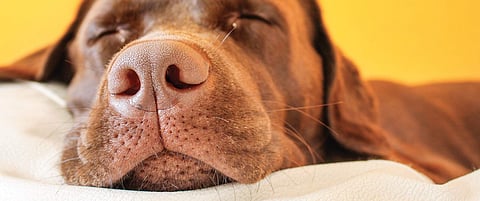

CHENNAI:It’s rumoured that at the end of the Beatles song A Day in the Life, Paul McCartney recorded an ultrasonic whistle, audible only to dogs, just for his Shetland Sheepdog. A dog can locate the source of a sound in 1/600 of a second and can hear sounds four times farther away than a human can. It takes eighteen muscles to move a dog’s ear. This specificity of motion helps the dog pinpoint the origins of sounds much faster than a human.
Similarly a dog’s sense of smell is up to one hundred thousand times more sensitive than a human. While humans have about five million scent receptors in their noses, a Bloodhound has up to three hundred millions. And while dogs have about 1,700 taste buds, humans have approximately 9,000 and cats have around 473. To know more about such fun facts about cats and dogs do read on. Cat and dog noses are like fingerprints. No two cats or dogs have the same nose – each has a unique pattern of ridges and creases, like a human fingerprint. The patterns can even be used to identify individual animals.
Dogs do dream like us. Dogs and humans have the same type of Slow Wave Sleep (SWS) and Rapid Eye Movement (REM) and during this REM stage, dogs can dream. The twitching and paw movements that occur during doggie sleep are signs that your pet is dreaming – probably of familiar activities like playing outside or chasing their tail.
Did you know that dogs’ eyes contain a special membrane, called the tapetum lucidum, which allows them to see in the dark? Also interestingly dogs have three eyelids, an upper lid, a lower lid and the third lid, called a Nictitating membrane or ‘haw,’ which helps keep the eye moist and protected.
We all know that dogs and cats can see in dark, but there is a general misconception that dogs and cats only see in black and white. Though their colour range is nowhere near as vivid as humans, it is believed that they see in murky shades of blue, greenish-yellow, yellow and grey, similar to our vision at dusk, and rely on contrast and movement to identify objects. They can see better when the light is low. Cats can’t taste sweetness, which explains why they neither seek out nor avoid sweet foods. Dogs, on the other hand, prefer natural sugars such as sucrose and glucose. A cat’s heart beats twice as fast as a human heart – 110 to 140 beats per minute. A cat’s purr is at the same frequency of a baby’s cry. Cats have learned to take advantage of our nurturing instinct through purring. Embedded within the naturally low-pitched purr is a higher frequency sound more like a meow or a cry. They reserve this sound for getting attention (not to mention food) from humans. Dogs are capable of understanding up to 250 words and gestures. Cats have a different type of intelligence and are less willing to participate in tricks and tests, which often leads to the perception that they’re not bright.
The cerebral cortex in cats (the area of the brain responsible for information processing and rational decision-making) has twice as many neurons as that of dogs, and it has been suggested that they have longer-lasting memories. Cats sleep for 70 per cent of their lives. That’s about 16 hours a day, more than any other mammal besides bats and possums. Additionally, cats spend 30 per cent of their waking hours grooming themselves. You must have observed your dog turn in circles before lying down...It’s an instinctive behaviour that goes back to their wild ancestry. Wild dogs would turn in circles to flatten down the grass to make a comfortable nest to sleep in, as well as shooing away any pests that might be hiding. Dogs curl up in a ball when they sleep due to an age-old instinct to keep themselves warm and protect themselves from predators.
Here’s a funny fact. When cats walk, their left front leg moves in tandem with their left back leg, and their right legs do the same. The only other animals that walk this way are giraffes and camels. Why do we see dogs with their tongues hanging out?
Dogs’ only sweat glands are between the pads of their feet. They dissipate the majority of their heat by panting, a method far more effective than allowing moisture to evaporate from the skin. A panting dog can take 300-400 breaths (compared to his regular 30-40) with little effort. Have you ever wondered why dogs kick after relieving themselves? They are using the scent glands on their paws to further mark their
territory.
Terms
Unique one of a kind
Rhinarium special type of skin that secretes moisture on the tip of the dog's nose with a unique design of dimples, dots and ridges
Biometrics using the uniqueness of a person's face, eye, or finger prints for the purpose of identification and security
High contrast image an image that darkens darks and white in the light areas
Procedure
Try washable ink prints to test dog’s nose
Create high contrast image of dog noses
High contrast images will show uniqueness of dogs’ rhinarium and nostrils
Compare each dog nose photos for similarities to describe the uniqueness of patterns